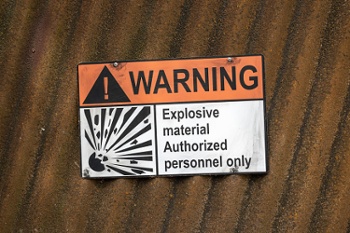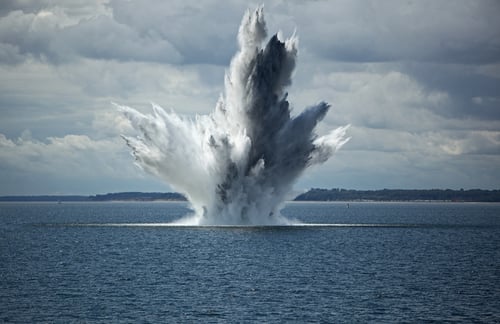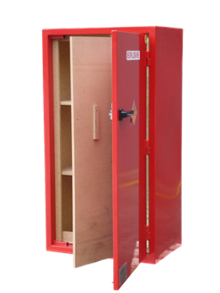Fireworks, bombs, detonators and gunpowder – we may know what explosives look and sound like, but do we really understand what they are? Recognised as Class 1 Dangerous Goods, explosives are used in a large range of commercial industries all around the world, possibly more than either you or I realise. From mining to entertainment, these goods are utilised in a range of businesses, but they come with serious hazards that need to be controlled. As dangerous goods, chemical explosives need to be stored and handled in a precise way to mitigate the risks of human harm, property damage and environmental destruction.
What are Explosives?
To find the definition of explosives, we can turn to the Australian Standard AS 2187.1-1998 – ‘Explosives – storage, transport, and use’, explosives can be defined as being:
‘A solid or liquid substance (or mixture of substances) which is capable by chemical reaction of producing gas at such temperature and pressure and at such a speed as to cause damage to the surroundings. Pyrotechnic substances are included even when they do not evolve gases;
A pyrotechnic substance is a substance or a mixture of substances designed to produce an effect by heat, light, sound, gas or smoke or a combination of these as the result of non-detonative self-sustaining exothermic chemical reactions.’
To simplify this definition, explosives are a substance (or combination of substances) that can react at such speed and pressure to emit heat, light, sound and gas in such a way as to cause significant damage to the surroundings.

These dangerous goods may be defined as goods which are capable of producing gas at a temperature, pressure and speed to cause damage.
Types of Explosives
Explosions in general is an extremely wide and technical topic to cover, so to keep it focused this article will be based on chemical explosions. However, there are essentially four types of explosions:
- Natural – explosions such as volcanoes and eucalyptus in bush fires.
- Mechanical – where the explosive is dependent on a physical reaction, such as the over-pressurisation of a substance within a compressed container. Note that this does not make every heated pressurised can or aerosol an explosive! Examples can include an overheated tank or boiler, or more simply a tin or compressed aerosol thrown into a fire. This application is sometimes used in mining and can also be referred to as vapour explosions.
- Nuclear - Nuclear explosions are rather self-explanatory – those explosions that typically derive their energy from nuclear reactions.
- Chemical – simply put, a chemical explosive is a substance or compound which will decompose rapidly producing gas and heat when applied with heat and/or shock. Chemical explosives are the most common — and possibly one of the most technical — types of explosives.
We’ll go into further detail about chemical explosives and how to handle and store these dangerous goods a little later in this post.

Chemical explosives, such as pyrotechnics, are one of the most common types of explosives used by industry.
History of Chemical Explosives
The first known explosive – Black Powder, (more commonly known as gunpowder) was a mixture that consisted of potassium nitrate, sulphur and carbon in the form of charcoal, and has been traced back to the 9th century.
Since then, there have been significant steps in the development of explosives, from the 1846 discovery of nitrocellulose (guncotton) – cotton and sulphuric acid – by chemist Christian Schonbein, and the 1946 discovery of Nitroglycerin by Italian chemist Ascanio Sobrero, consisting of nitric acid, sulphuric acid and glycerol. The blasting cap for nitroglycerin was invented by Albert Nobel in 1865. TNT was invited by German chemist Joseph Wilbrand in 1863, and is still commonly used today, particularly in the military. Dynamite was patented by Nobel in 1967, a relatively safe and powerful high explosive. Later, around 1888 Nobel and others invented a number of smokeless powders.
Naturally, since then, there has been an outstanding increase of understanding of explosives right up until today and research, development, testing and production of such substances is ongoing.
Forms Of Explosives – Rate of Combustion and Sensitivity
Chemical explosives are further broken down into categories according to their rate of combustion as per the following;
Low Order Explosives
Low order explosives are those that will decompose at a subsonic speed – that is, slower than the speed of sound. Low order explosives do not typically detonate, but rather deflagrate. This means that the explosive will burn and release gas, without a shock wave. The most common low order explosive can include gunpowder, fireworks and some pyrotechnics, propane and fuel. Low order explosives are most commonly used as propellants.
High Order Explosives
High order explosives are those that will decompose at a supersonic speed – that is, faster than the speed of sound. High order explosives will usually detonate in comparison to deflagration. This means that the explosive reaction is proceeded by a blast shock wave that is followed by an extremely rapid burn rate. The pressure of the blast front holds the most significant danger and will be the cause of the majority of the damage or result of the reaction. High order explosives are most commonly known for their use in the military and mining industries.
High order explosives can be further categorised according to their sensitivity;
Primary Explosives
Primary explosives are extremely sensitive and reactive. They can hardly be handled without detonating as a cause of shock, heat or friction. Because of their extreme sensitivity, primary explosives are often used in very small quantities as an initiator, to shock less reactive explosives into detonation. Commonly used in blasting caps to translate a signal in an explosive train. The form of signal can vary on the application.
Iodine nitride, lead azide, mercury fulminate, tetrazene and DDNP are examples of primary high explosives.
Secondary Explosives
Secondary explosives are less reactive than primary explosives and comparatively, need a significantly increased level of energy to evoke a reaction. This makes secondary explosives a lot safer for handling, usage and storage. Secondary explosives are often initiated by a small amount of primary explosive and are sometimes referred to as base explosives. TNT, RDX and PETN are common examples of secondary high explosives.

TNT is a common type of secondary high explosive, which can be used in mining and exploration.
Tertiary Explosives
This third sector of high explosives is often debated, and sometimes classified as a subclass of secondary high explosives. Tertiary explosives are sometimes also known as blasting agents.
In comparison to primary and secondary high explosives, tertiary explosives are extremely insensitive to shock. These explosives can’t be detonated by a small amount of primary explosive alone. Instead, they require a primary explosive to detonate a secondary explosive, which will detonate the tertiary explosive.
Despite sounding very similar, the definition of a low order explosive and high order explosive does differ from the meaning of a low order explosion and a high order explosion.
A low order explosion is where the reaction will deflagrate, and a high order explosion will detonate. Typically, low order explosives will produce low order explosions and high order explosives will produce high order explosions. However, should a low order explosive be put under a certain high degree of pressure, it’s possible for it to create a high order explosion.
ANFO is a common tertiary explosive, with emulsions and water jells increasing in popularity.
Explosive Train
An explosive train is the sequential ordering of explosive components according to their classifications of sensitivity to detonate a relatively safe, predictable, practical and measured explosion according to the perimeters of the project and surrounding influences.
As we mentioned in the previous section, there are three core forms of high explosives:
- Primary Explosives: these are extremely sensitive and reactive
- Secondary Explosives: in comparison, these are relatively insensitive
- Tertiary Explosives: in comparison to the former types of explosives, tertiary explosives are extremely insensitive.
REMEMBER: Naturally, large amounts of primary explosive are extremely dangerous and expensive. In comparison, tertiary explosives are cheap and safe but exceedingly hard to detonate.
Typically, an explosive train has three explosive components, and is most common in industries such as mining and construction. To commence the process, a signal, (in industrial sectors) generally in the form of a physical shock, will initiate a very small amount of primary explosive – often referred to as an initiator or blasting cap. The primary explosive will detonate, translating the shock through to the next sector of the explosive train – where the secondary explosive is.
Often referred to as an intermediary or booster, these explosives are sometimes contained within the blasting cap of the primary explosive. This part of the explosive train will then detonate the third and final stage – that of the tertiary explosive, the sector within the train commonly referred to as the main charge, or bursting charge.
REMEMBER: Not all explosive trains are the same. A high explosive train can have as few as two sectors, or as many as four, depending on the particular usage, the substances in question, the environment, and the goal behind the explosive train.
Basic Chemistry Behind Explosives
The chemistry behind explosives and explosions is mammoth, and like all technology, science and chemistry research, is constantly being improved.
An explosion needs two basic ingredients: an oxidizer, and a fuel. Without getting too technical, we know that an explosive is a substance that after being initiated by a force or number of forces such as heat, shock or pressure, undergoes a highly exothermic reaction with a significant positive entropy change in the form of either detonation or deflagration (depending on weather the explosive in question is a high order or low order explosive) ultimately creating a redox reaction. Breaking the result down, we have a huge amount of gas and heat. The gas immediately compresses (creating the sound) before expanding to create a blast wave.
If you have ever watched an explosion in slow motion, you will know and understand how the pressure of the shock wave is possibly the most dangerous part of the explosion, its intense power breaking everything in its path. Fragmentation of an explosive adds an entire additional dimension to the reaction, and a whole lot more damage.
Physics explains how the shock wave is a massive wave of increased pressure, which is followed by a section of relative negative pressure, creating an opposite force behind the pressure front. In some massive scale explosions, it’s possible for the resulting force behind the pressure wave to be below normal atmospheric pressure.
It’s important to note that one characteristic of an explosive is that the initiation source, such as heat, will not contribute to the energy of the explosion. An explosive is a substance that can create an explosion by its own energy.
Explosives Storage
Once you have a little understanding of the properties of Class 1 Dangerous Goods, you will understand how crucial it’s to store explosives in a safe manner.
To assist with safe Class 1 storage, Standards Australia have created AS 2187 Explosives – Storage, transport and use’ outlines the recommended requirements for the storage of Class 1 - Dangerous Goods.
These storage requirements include;
- The interior of an explosive storage unit, such as a box or cabinet, must be fully lined with wood.
- The explosive storage cabinet must be constructed of sheet steel of 0.8mm thick or sheet aluminium of 1.1mm thick.
- The storage device must be painted externally and internally.
- The storage cabinet must be equipped with handles for lifting.
- The explosive storage box must be outfitted with a lid that is close fitting, and secured with a metal hasp, steel staple and steel hinges.
- Should the explosive storage unit be used for gunpowder, the hinges, staple and hasp must be constructed from brass.
- The explosive storage device must be fitted with a six lever 'safe lock'. If a padlock is used, it must provide a high level of resistance to fracture or rupture. If the padlock is a pin-tumbler, it must have a 'restricted key system'. Lever type padlocks must have at least 5 levers.
There are two common forms of explosive storage units to help you out with your day-to-day operations in the business. For the more permanent storage of explosives, we recommend storing your goods in a compliant Class 1 explosives cabinet.
For the daily transport of explosives on site, we suggest keeping these goods in an explosives day box. Explosive storage day boxes are ideal for the safe transport, cartage and storage of explosives – particularly detonators.
Explosive storage must meet a string range of requirements, as per the Australian Standards.
Ensuring Safety with Chemical Explosives
In relation to the chemical and physical properties of explosives, it’s easy to demonstrate the level of risk such substances present to people, property and the environment. One way of significantly reducing the risk associated with explosives is to store them in a safe manner, compliant to the Australian standards. If you’re interesting in learning more about the properties of the different classes of dangerous goods, you may download our free eBook by simply clicking on the image below. Our guide will lead you through all 9 DG classes and offer tips for safe and compliant storage and handling practices. Get your free copy today to find out more.
Joining the team as a Dangerous Goods Storage Consultant, Melissa Hampton became Storemasta's Marketing Manager in late 2021. With extensive knowledge and experience in chemical compliance, Melissa is responsible for leading the Marketing team and helping shape their marketing strategy. In her spare time, you can find Melissa hiking, swimming and enjoying the great outdoors in beautiful north-west Tasmania.

